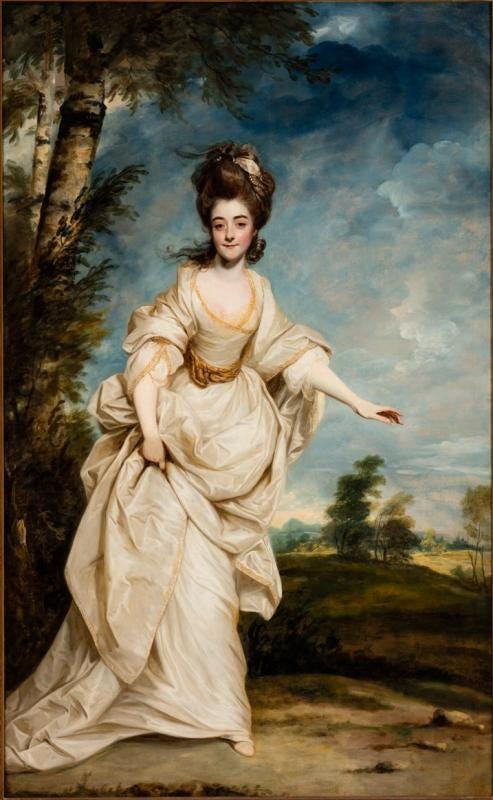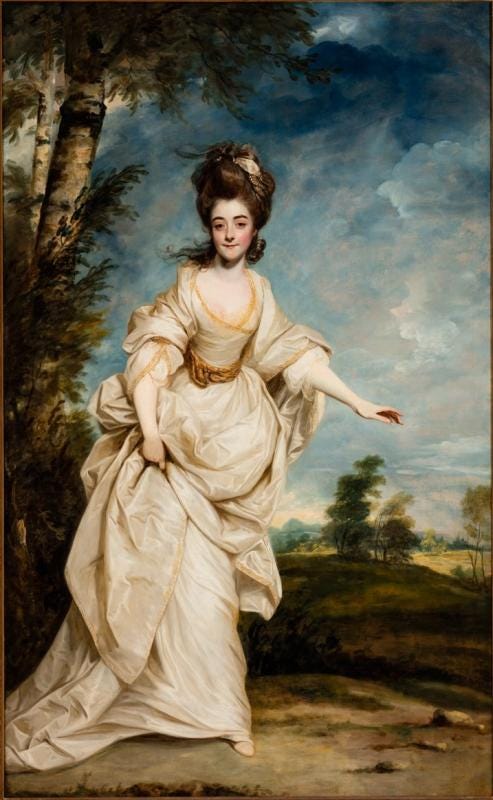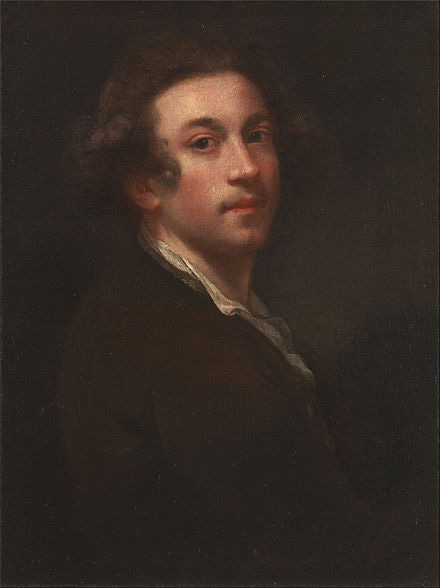Viscountess Crosbie's Sweet Silk Skirts
Click to travel to 1777 London via Sir Joshua Reynolds' portrait of Diana, Viscountess Crosbie née Sackville
21st & 18th writes about culture. Covering art, history and fashion across the 18th century through to today. We feature interviews with voices in fashion and leaders in the arts. Written by Lauren Lynch Wemple (@lolynchwemple). Follow 21st & 18th (@21stand18th) on Instagram.
ART
She hangs, made immortal by Sir Joshua Reynolds1, in the wood paneled, windowless portrait gallery of the Huntington Library, Art Museum, and Botanical Gardens - and once you’ve seen her, she’s unforgettable.

If you are keen to know more about the Huntington, one of the foremost scholarly institutions in the United States and their rare and expansive collections of books, manuscripts, art and flora, I suggest you read 21st & 18th’s interview with Dr. Vanessa Wilkie, the William A. Moffitt Senior Curator of Medieval Manuscripts in British history and the Head of Library Curatorial.
The year is 1777 and Diana Sackville is a soon-to-be Viscountess, engaged to John Crosbie, Viscount Crosbie and the heir to the Earl of Glandore, an Anglo-Irish aristocrat born in Ireland and educated at Trinity College Dublin.
Our main gal, Diana, was 21 years of age in 1777, having been born on July 8, 1756 the eldest daughter of five children by Major General, George Germain, Viscount Sackville2 and his wife Diana Sambroke3. To understand Diana, let’s dig into her parents a bit because whose parents haven’t contributed to their children’s mental health issues.
First, her father, Lord Sackville: A younger son of the Duke of Dorset, which meant as a high placed younger son he had all the education, connections and breeding of his elder brother, the heir to his father’s dukedom, but he was not predestined to inherit. As in most cases of younger sons, he had to make his own way to a point and joined the military to do so. Her father, born simply Lord George Sackville, was bestowed the title of 1st Viscount Sackville in 1782 following a winding and shall we say interesting career in the British Army. We don’t have time to dive deep into Lord Sackville’s military exploits but the highlights go something like this: He partook in a number of battles ie. first being the War of Austrian Succession in 1740, he began rising through the ranks but his success was momentarily dampened when he was demanded to stand trial via court martial for failing to follow orders in the Battle of Minden in 1759 the result was Lord Sackville was found guilty, his military titles were stripped and he was legally declared "unfit to serve His Majesty in any military Capacity whatever" whoa, somehow upon the ascension of King George III to the British throne in 1760 he slowly rehabilitated his military and political career and in 1765 he was reinstated in his role within the Privy Council4 , in 1769 Lord Sackville became Lord George Germain upon the death of a wealthy relative from whom he inherited an estate and loads of money what luck!, in 1775 the guy became Secretary of State and in 1776 he gets involved with the American skirmish in the War of Independence.
Let us stop here as that brings us to 1777.
So our main girl Diana, has a father who is part younger son of a duke, part court martial-ed fool and part Secretary of State with a load of money/the King of England’s ear - very interesting.
Sadly in terms of Diana’s mother, Diana Sambrooke, we know nothing save for the year she was born, 1732, date she was married, September 3, 1754, the children she gave birth to, the names of her parents, John Sambrooke and Elizabeth Forester and the date she died, January 15, 1778. Super depressing, I know.
Diana, our Diana, herself was a bit of a conundrum. There are two recorded accounts of Diana as a young 20-something, from other ladies of her class, on one hand she was noted as being, “conceited and disagreeable, a sort of pattern Miss who lectured us all upon propriety." Alternatively, another lady described her as, “a possédée5 that makes herself perfectly easy wherever she goes, and has so very little doubt of not being welcome everywhere, that she makes no scruple of inviting herself." Funny, funny
Let’s take a look at Diana
Reynolds has depicted Diana as he does all his aristocratic female portrait specimens: in some type of motion and amongst a lush landscape reminding the viewer of certain persons mastery over life, society and nature.
Diana is perfectly pale with rosy cheeks, she has an elongated oval head and despite her movement and placement within mother nature, who seems to be willing a storm to clear or thicken one can’t be sure overtop her head, her perfectly quaffed hair has come loose in only the most correct areas. Diana appears girlish yet on the cusp of something, and that something is womanhood. Reynolds painted this portrait in 1777 with Diana’s marriage to Viscount Crosbie taking place on November 26 of the same year.
This portrait is like the ultimate in engagement photos or a boudoir book, Reynolds and the Sackville family is basically saying, here she is, perfect yet open and exciting and enticing, take her hand and everything else, Crosbie!
My favorite part of this portrait is how Reynolds has given Diana movement, her silk gown is rustling, moving as she pulls up her skirts and moves her arms, naturally, to match her energetic stride.
I am lost in the color of her dress, which is interesting as it is effectively a neutral, but Reynolds has given her beige gown golden and ivory hues, it sparkles and the golden braids at her arms and around her waist, remind me of ancient greek goddesses, enticing and exotic, promising devout worshippers a fun and fruitful future.
Notice how expertly Reynolds gives something so simple, as the silk of a woman’s skirts, perspective. In her skirts, he’s given us depth and movement. His paint strokes have captured the sounds of silk swishing sweetly on a balmy spring day. One can hear them crumpling.
Another deftly painted bit of this portrait is Diana’s legs and feet.
As we can see she is obviously pulling the skirts of her gown upward to walk more freely and easily, however all the viewer can see of her body is her elegantly, slipper clad right foot.
Genius, Reynolds, genius!
To have shown Diana’s ankle or more of her leg would have been an absolute joke. After all, at the time she was an unmarried lady of the peerage, not some stage-going-woman-of the night.
To show us, and her soon to be husband, Viscount Crosbie, only her foot, we see a sweet, young and open woman who is vivacious. To see anymore, her portrait might lose its positive glint. It’s a fine line between blushing bride and harlot, but there you have it - I didn’t make the rules in 18th century England!

What do you think of Diana?
I look at Diana and mostly think she looks like a good time. I’d love to be her friend and know her secrets but mostly have access to wearing her gowns.
Reynolds, an expert portrait painter, particularly of women, knew how to adroitly deliver bits of information about his sitter’s personality. I have no doubt, he smirked to himself as he painted Diana’s curious smile and sparkling eyes - there is indeed some joke or secret behind them - I wonder what it was? Did Reynolds know? That we will never be able to uncover.
However we do know that after her marriage, Diana did get herself into quite a bit of trouble due to her obsession with partying and gambling which sadly added an air of frustration to her marriage as she found herself in mountains of debt for several years of her life.
In addition to her frivolous gaming obsession, she and her husband were never able to have children, at which Diana felt great anguish.
On her husband’s succession as the 2nd Earl of Glandore in 1781, Diana became the Countess of Glandore and lived out the rest of her life in Anglo-Irish society. In August of 1814, Diana died in Ireland and was buried at the seat of her husband’s family, Ardfert Abbey, in County Kerry. Because she and her husband did not produce any children, the title, Earl of Glandore became extinct upon his death the following year in 1815.
Woof, I mean…How does knowing this background on Diana and her marriage impact how you see Reynolds’ portrait of her?
For me, I’m saddened. Reynolds gave us a girl about to be in her prime on the cusp of all of it - whatever it was - and in possession of charm, energy and position. The Diana of 1777 was ready to take over society, keen to be a wife and be free to explore the roads which were set to open up upon leaving childhood and the home of her parents behind.
I suppose Diana’s 1777 self is a snapshot of perfect time when things were possible and her potential and confidence were all that mattered - not dissimilar to our Instagram profiles or wedding invitation suite: frozen moments of our lives that allude to greatness and exciting things to come.
Like Reynolds painting the legacy of his sitters and Diana of 1777, all we really have is the present. Because either the future isn’t going to be as grand as we think or, even scarier still, we might not see tomorrow. Is that too stoic a note to end on? I think it’s rather self assuring to think of this moment, this time and day as the best we’ll be - it reminds us to live and take action in a way that aligns with how we wish to be remembered.

Sir Joshua Reynolds was born in Plymouth, England on July 16, 1723 and died at age 69 in London in the winter of 1792. Reynolds is recognize chiefly by his body of portrait work done in the Grand Manner style, full length, life size or larger, paintings which utilized visual metaphors to deepen the viewer’s reception and meaning of the sitter. Reynolds admired the work of the Old Masters, whose works he came into contact with at the end of his five years spent studying art, first in London and later in Italy. Reynolds devoted his work to elevating the craft of portrait painting and is remembered around the world by his portrait snapshots of aristocrats, the social and political who’s who and intellectuals of the 18th century.
Thanks for reading - I’m curious to know what you think of Reynolds’ Diana of 1777 or if you’ve seen his work IRL. Have you been to the Huntington in Southern California? Write me in the comments below or at lauren@21stand18th.com. Cheers.
(b. 1723 - d. 1792) Sir Joshua Reynolds was a British painter known for his Grand Manner style portraits which completely changed portrait painting in Georgian England.
(b. 1716 - d. 1785) Born Lord George Sackville, he was bestowed the title of 1st Viscount Sackville in 1782 following a long and dramatic military career in the Royal Army.
(b. 1732 - d. 1778) Sigh, unless women made a big noise, positively or negatively, we know nothing at all about their lives at this time.
Essentially the Privy Council were a group of parliamentary advisors elected by the British Monarch. While the Privy Council does work with and offer advice to the monarch, the actual power lies with the Prime Minister and Cabinet, who are accountable to Parliament.
Meaning self-possessed as in confident and sure of one’s self especially socially







